James Morris of English Gardens Landscape Company shares his experience and advice on implementing software
If the thought of implementing new landscape business software sounds challenging, you aren’t alone. It’s a task that many landscape companies put off simply because they don’t know how they will be able to dedicate the time or effort to it that’s needed.
James Morris, director of landscape and holiday decorating services for English Gardens Landscape Company in Pontiac, Michigan knows firsthand that implementation is no simple feat—he is in the thick of it now, at the time this was written. And he shares outright: “The number one lesson we’ve learned so far is that there’s never a good time.” He says you need to jump in—and it’s going to be tough at times.
Morris has provided a few tips on what he’s learned thus far that he hopes will help other landscape companies through the implementation process.
Allocate More Time Than You Think it Will Take
One of Morris’ first tips is to expect the process to be time-consuming. He says you might even want to double the amount of time that you think it’s going to take so that you’re prepared and avoid disappointment.
“We are a pretty organized operation, and we have things running smoothly, but implementation has still taken a lot more time than we initially expected,” Morris says. “There is just a lot that you don’t know as you first start out. Even with Include Software’s support, we’ve had to allocate more time to the effort than we anticipated.”
Ask Tons of Questions (But Understand You Won’t Always Know What to Ask)
Morris says that he would also recommend asking lots of questions. The company has leaned on the Include team where it’s been able to—but he also admits that sometimes you “don’t know what you don’t know.”
In other words, they haven’t always known the right questions to ask.
“No matter how much you plan and how many questions you ask, there are always going to be unexpected situations that come up,” he says.
Morris says that understanding that “surprises” are going to arise can decrease the feelings of frustration that tend to come with them.
When English Gardens was in the process of deciding whether or not to invest in Asset, Morris says that they relied heavily on references. That helped them to solidify the decision. Now, in the implementation process, it’s also been another source to lean on and ask questions, too. Watching these other companies’ experiences has been helpful in terms of what to expect.
Concentrate on the “End Results” When You Can
The early stages of implementation can be a lot of work—and sometimes frustrating for team members. It will require them to learn new ways of doing their job, says Morris, and change isn’t always easy.
“We try to emphasize that yes, their jobs are changing—but changing for the better,” Morris says. “We concentrate on the end result as much as possible. We are just now starting to see a vision of what it will look like as we move into that new phase and we’re trying to stay focused on how things will improve.”
Morris adds that believing in the product and what it can do for everyone is important. They talk openly about the positive changes they look forward to seeing.
“One of those changes will be streamlining all of the data tracking we do,” he continues. “We currently use multiple spreadsheets to track everything and each of those spreadsheets is managed in different ways. Having all of that data in one easy system and giving key people access to the data that they need will help us to manage our business way more effectively.”


